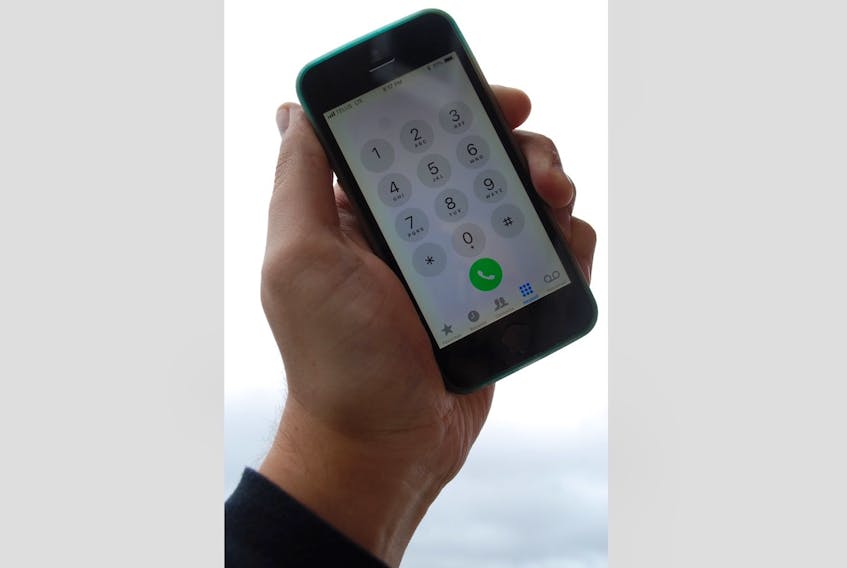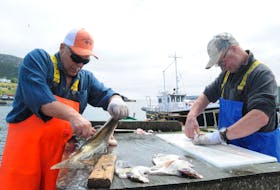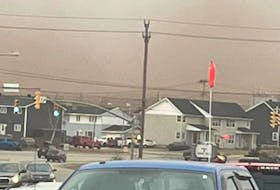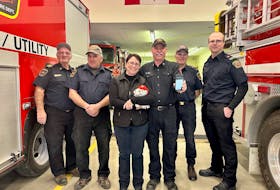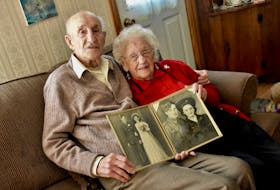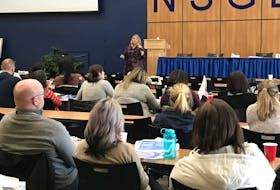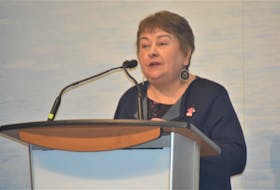DAVID HOLT
SPECIAL TO SALTWIRE NETWORK
John Henry Low and his wife live in the northeast United States. Recently, they discovered Newfoundland and Labrador, and isolated Battle Harbour, off the coast of Labrador, has become a refuge from their busy lives.
“A few weeks ago, we packed our bags and made an emergency trip,” he says. “The ‘iceberg therapy’ did the trick.”
This story is not uncommon; the province has become something of an international destination. Tourists come from across the globe seeking the peace and beauty they don’t find at home.
Not surprisingly, when they get here, they find their cellphones don’t always provide the basic functions they rely on day to day. Besides voice, they want to take photos and videos, navigate, search, and share text and images. Many use the phone to keep in touch with the office, the new normal even for those on vacation.
On paper, the province is well covered. Bell, the largest investor in communications infrastructure both in Atlantic Canada and nationally, claims that 96 per cent of the population in the province is covered by its wireless network.
Rogers, meanwhile, says it continues to invest in its wireless network, which currently covers a large part of the province's population. It touts its unlimited data plans through Rogers Infinite, says that it was the first national carrier to launch this sort of worry-free wireless.
But it’s not a simple story. A lot of the population is along the Trans Canada route from St. John’s to Port aux Basques.
“There are cell towers in the larger areas, but some regions are suffering,” says consultant Mark Ploughman. “In a lot of places, you drive to the top of the hill to pick up the signal, otherwise it drops out.”
Residents of many smaller communities get in their vehicle and drive to find better reception.
Newfoundland and Labrador is a big province, with “dead zones” common on the routes less travelled. The six-hour drive from Goose Bay to Labrador City has no cell service. Same with the north coast and most of the Northern Peninsula. Travellers on the Burin Peninsula hit a dead zone for about 50 kilometres between Swift Current and Marystown.
Dead zones
Cell towers cost about $600,000 each and have a range of about 30 kilometre.
“The carriers are businesses that typically want a one-year payback from capital investment,” says Ploughman. “Their business model is to look for incremental revenues from new subscribers.”
None of that works in rural areas.
“Still, the cell coverage in Newfoundland and Labrador is pretty good, considering there is a low population density spread over a large terrain with difficult topography,” says Ploughman,

who is often on the road.
“The fishing villages were founded in sheltered coves along the coast. They tend to be basin-shaped, with access to the ocean and hills behind. They are sheltered from the wind — and also from cell signals.”
Every community would like to be within range of a tower, but in many rural places, the economics just don’t make sense. In 2018, the provincial government launched a cost-shared cellular service pilot program that will contribute up to a maximum of 25 per cent of project costs towards cellular coverage infrastructure upgrades. The original pool of $1 million assumes carriers and communities will come up with the rest.
Ploughman is a former assistant deputy minister for innovation and strategic industries and a former acting chief executive officer of Research and Development Corporation of NL. As an ADM, he had the rural broadband file.
“The program provided subsidies to carriers to upgrade and/or provide service in rural areas,” he says. “We realized that many consumers of bandwidth are mobile. But land-based services are mostly fibre and co-ax cable. We need to improve access to mobile bandwidth.”
It’s only been over the last 10 years that the “smart phone,” now also a miniature computer, camera and internet connection, has become the dominant link to the digital world. Most of the platform companies, as they are called, quietly pivoted their strategies to focus on these devices. While the hardware is brilliant and relatively cheap, it’s software that drives the industry.
Voice service is just one feature of a complex package.
What’s more, most of the programs we take for granted are designed to be addictive, each one quickly adapting to the usage patterns of the individual. The short version: most of us can’t live without our phones.
“There is a social need to talk to the family and an economic need today where businesses can’t operate without cell service.”
-Tony Keats, the president of Municipalities Newfoundland and Labrador
Building business
In rural areas, reliable cell service is needed to attract and retain both residents and businesses. It’s a demographic issue, too: younger people, especially, demand it, and they are the future.
But there’s a catch. Build it and they will come – but not necessarily. Cell service is just one of the parameters of a thriving community.
Tony Keats, the president of Municipalities Newfoundland and Labrador, is based in Dover, about 40 minutes from Gander. The organization covers 276 incorporated towns.
“There is a social need to talk to the family and an economic need today where businesses can’t operate without cell service,” he says.
“It really hurts the ability of tourism operators where visitors expect to be able to use their cell phones, to use debit cards and Interac. When they find out the cell service is spotty at the best of times, it takes them back.”
He also cites safety issues along the long sections of highway where there is no service.
Still, Keats is optimistic.
“The federal government set up a new ministry of Rural Economic Development, to ensure rural broadband and cell coverage are available across the country. We’ve been advocating that for a long time.”
“Good cell service is something they expect."
- Cliff Rowe, owner of Fogo Island Freight
Road warriors
Cliff Rowe, owner of Fogo Island Freight, has been in the trucking business for 49 years. His company has nine trucks that work throughout Newfoundland and Labrador.
“We depend on cellphone service, which is not that great in rural areas,” he says. “I’m on an island. We don’t have good cell service here. There are cell towers in place, but coverage is spotty. We often lose the signal. It’s a nuisance in this day and age. It should be a better set up.”
The trick in his business, he says, is to know where there is no signal. His drivers pull over to use local Wi-Fi. Back at the office, he knows where his drivers are and works around the dead zones.
“I know when they have a signal when they don’t.”
His young drivers especially rely on their phones. It’s a community issue, too, he says. Lately, younger people have been returning to the island.
“They are older and wiser and want to settle into something closer to home,” he says. “Good cell service is something they expect."
"We need to help the tourism sector. We are competing in the global market.”
-Colin Corcoran, Genesis Centre at Memorial University
Building a model
Colin Corcoran, a chartered professional accountant who is director of finance at the Genesis Centre at Memorial University, used to own the Keltic Knot restaurant in St. Mary’s Bay on the Irish Loop. The region includes four towns and a total of 13 communities.
“Tourists on their cell phones came in trying to catch a few bars,” he says. “When they can’t use Google Maps and Trip Advisor, they finally look up from their phones. We are not a diversified economy. We need to help the tourism sector. We are competing in the global market.”
The solution came from a social enterprise, SMB Connect. As a private company, Bell Aliant couldn’t justify the expense, says Corcoran.
“We came up with a business case and the financial model that shared the cost among the carrier, the province and the community. It was a creative way to deal with an economic development issue.”
The result was a $1.1 million infrastructure deal for St. Mary’s Bay, with Bell paying 50 per cent and the province and the community paying 25 per cent apiece.
The backdrop is the changing fabric of the community, including the economy and demographics.
“When I ran the bar, I would talk to young fellows who said they would like to move home,” says Corcoran. “A large percent fly in and fly out. They would like to move back. We all romanticize our connection to ‘the Rock.’”
This is the only way for rural regions to succeed, he says.
“We wrapped the model in a social enterprise, where there is the triple bottom line of profit, and also benefits for society and the environment.”
The Cellular Service Pilot Project, as it is called, reached more than 12,000 people. The Department of Tourism, Culture, Industry and Innovation is extending the pilot initiative in 2019-2020. During the 2019 provincial election, the Liberal party committed to enhancing cellphone coverage across most of Newfoundland and Labrador.
Bell’s partnerships to date with the Government of Newfoundland and Labrador’s cellular service pilot project include the communities of Mainland and Three Rock Cove, several communities on the Great Northern Peninsula, in St. Mary’s Bay and Southern Labrador, as well as King’s Point, Pouch Cove and Lord’s Cove.
“Before the two new towers, once you went out of town, there was no coverage.”
-Sam Elliott, St. Anthony Basin Resources
Building on strengths
St. Anthony, on the on the tip of the Great Northern Peninsula, has a long history in the fishery and a growing tourism sector. Besides the UNESCO World Heritage Site at the Viking settlement in L’Anse aux Meadows, there are attractions like hiking, berry picking, moose hunting and snowmobiling.
But something was missing.
“Before the two new towers, once you went out of town, there was no coverage,” says Sam Elliott, executive director of St. Anthony Basin Resources (SABRI), another social enterprise.
The new infrastructure is the result of the cellular service pilot initiative, where the $1.4 million cost of providing service to 16 local communities is shared by Bell Aliant (50 per cent), the provincial Department of Tourism, Culture, Industry and Innovation (25 per cent) and SABRI (25 per cent).
It was a traditional industry, the fishery, which allowed the community to participate. When the shrimp fishery took off, SABRI received an initial 3,000 metric tonne quota. It partners with Clearwater for the harvesting.
“You get a royalty, there is employment,” says Elliott.
Although the quota has been reduced, the royalties allowed SABRI to pay its share of the pilot project.
The funding provided a Long-Term Evolution (LTE) tower in Raleigh, and a cheaper, short-range SimpleCell pole in St. Lunaire-Griquet. The project improves the mobile network coverage and brings High Speed Packet Access and LTE mobile technologies.
The region has about 4,000 to 5,000 residents, but 30,000 tourists each year come to visit L’Anse aux Meadows alone. To capitalize, SABRI built a floating dock that hosted 14 cruise ships last year.
“When people come ashore, they bring their cell phones and expect to be on the Net,” says Elliott. “They don’t come ashore with their laptops looking for Wi-Fi.”
Cell service also helps with services like medical and fire. It’s all about rounding out services to improve overall quality of life in the area.
The latest project is a seniors’ home so people can stay in the community with the services they need. At the other end of the scale, “young people need their new technologies.”
Meanwhile, Elliott says, “business people come here on vacation with their phones — they can even run their businesses from rural places if they have Wi-Fi — away from the hustle and bustle of world of urban life.”
“My big concern is that when someone is injured, time is of the essence... If you have to drive to the next house for coverage, it can add an hour.”
-Duane Antle, firefighter
The life savers
Duane Antle of Come by Chance has been a firefighter for 25 years. Today, he is the past-president of the board of directors of the Newfoundland and Labrador Association of Fire Services.
“We rely more and more on mobile phone apps to get emergency calls,” he says. “Getting improved cell coverage is a work in progress. But the system is working pretty well in his area.”
In an emergency, communications is essential, he says. Small communities rely on the traditional telephone system and many of the smaller departments depend on local pager systems.
There are times when the local pager system has dead spots, he says. If you’re on the highway, for instance, a pager system doesn’t work well.
“As an association, we recommend departments keep the pager system because the cell system can go down,” he says. “We are also advocating for a province-wide radio communication system. It looks like it will happen, but it is expensive.”
For firefighters, reliable cell service is the best option.
“When you leave the fire hall, some of the communications you want to keep confidential,” says Antle. “The other advantage is that everybody has a cell phone today. There are apps where you can access pre-plans for fires. You can see who’s coming to the emergency. When everyone is equipped with a cell, it is easier to work together.”
For now, there can be dead zones along long stretches of road.
“My big concern is that when someone is injured, time is of the essence,” he says. “Within minutes, we want to roll the emergency services to increase the chances of survival. If you have to drive to the next house for coverage, it can add an hour.”
Bringing them home
Fishers’ Loft Inn on the Bonavista Peninsula is part of a growing tourism sector on that part of the island. The son of the founders, general manager Luke Fisher grew up in the business.
“Our area is a well-known destination and our coverage is good compared to smaller places,” he says.
Telus piggybacked on Bell’s towers, he says, which made for increased competition and improved service.

“We are lucky to have good coverage,” he says. “People insist on cell or Wi-Fi. With more competition, guests are generally happier. Before, they would get frustrated that they couldn’t check email, work or make calls.”
There are holes in the coverage, but Fisher knows where they are; three or four spots on the drive to Clarenville, for example.
“That’s the reality of Newfoundland,” he says. “I feel privileged to have the ability to connect where I can. Our world relies on the internet too much. People are so absorbed in their phones — it’s crazy.”
His phone rings.
“Some days, I was a wish I had less service,” he says.
Finding solutions
These days, the smartphone is often the gateway to the internet. The original cell system, designed for voice, did not have the capacity to meet the bandwidth demands required as a result of the evolution of smartphones. Expectations keep rising.
“People expect cell coverage to be ubiquitous,” says Ploughman. “They expect service in the wilderness in case they run into trouble. That is unreasonable.”
Corcoran likes the social enterprise approach to creating the partnerships needed to build new infrastructure in rural areas.
“Deploying a social enterprise helps to build the community,” he says. “It’s a model based on local values.”
Across the globe, there is a growing divide between urban and rural, he adds.
“Their fates are tied together. What has been learned and earned in the urban area can be translated to the rural. The whole society needs thriving regions to maintain infrastructure and a tax base.”
Wayne Kelly, at the Rural Development Institute at Brandon University, Manitoba, is an expert in rural issues. He coordinates a research partnership among universities, non-governmental organizations and government departments, with funding from the federal government and elsewhere. Both MUN and the Rural Development and Rural Secretariat Newfoundland are partners.
“Rural places in Canada have less access to cellular, poorer quality and higher costs,” he says.

The internet impacts so many facets of life in rural areas, says Kelly.
“Business needs access to global markets and suppliers. Consumers need to shop, explore and be entertained,” he says. “Services like telehealth provides savings and reduces stress on patients. It helps an aging population with loneliness.”
They spend more time and money on their mobile devices, he says, and they have a greater adoption of technology. On the other end of the scale, young people are the future, and increasingly, they want to be connected.
“The Net is a critical tool for younger generations to build social capital, like a coffee shop in the old days,” he says. “Young people don’t use the voice feature. What they really need is affordable data.”
It’s not realistic to expect the free market to deliver all these services in rural places, he says. This is where you need more support from government and the communities themselves. Increasing both the adoption rate and the skill level to drive demand is also essential. This is the second level of the digital divide.
In small towns, there are many businesses without websites, which Kelly says means rural businesses have a hard time keeping up.
“Business needs that presence. In an issue that affects both business and residents, many people say they will not buy a home in the area that does not broadband access.”
Both the Canadian Radio-Television and Telecommunications Commission (CRTC) and the federal government have reinforced that data speed is important.
“In urban areas, you can get unlimited data as part of your package,” he says. “That is a critical piece. In Canada, we have some of the most expensive cell plans in the developed world. When I was in Ireland last year, I could get a cell package with unlimited data for $30 a month.”
The art of conversation
A tourist’s views on lack of cell coverage in Newfoundland and Labrador
BY JOHN HENRY LOW
Driving along Newfoundland’s West Coast and Great Northern Peninsula on the way to Labrador, we found Bell Aliant cell service in the bigger towns. But there was no signal at all in our favourite place: L’Anse aux Meadows. Today, its population is around 30, only a third of the population of the Vikings when they spent five years there.
We have driven the Trans Labrador Highway Coastal Road, which goes as far north as far as Port Hope Simpson. A couple of the small, southernmost towns have cell reception. In fact, if you drive the Trans Labrador Highway from Port Hope Simpson to Happy Valley - Goose Bay and Labrador City, they loan you satellite phones for safety along that long 600-mile stretch of wilderness.

There’s no cell reception on Battle Harbour Island or in Mary’s Harbour from where the Battle Harbour ferry departs. But that lack of coverage adds to the charm. Battle Harbour Island is a living history museum. They have family-style dining where everyone sits at the same long tables. Not having everyone’s eyes glued to their screens makes for an engaging experience.
There is a private microwave link for internet service back to their office on the mainland. And they use old-fashioned Magic Jacks for phone service and offer that to guests as well. There is only one area on the island with Wi-Fi for guests.
New cell towers are being built in the coastal towns along the Trans Labrador Highway. There is concern that if a cell tower comes to Mary’s Harbour or St. Lewis, NL across the bay, the guests at Battle Harbour would lose themselves in their screens at the dinner table.
While many people want seamless cell phone coverage, the economic reality of sparsely populated areas doesn’t permit it. If you need that coverage, you might be better off moving to Toronto. If you enjoy the area’s natural splendour, then consider poor cell coverage an enhancement of that beauty.
Access to mobile
In 2016, the CRTC declared broadband access including cellular to be an essential service. In June, the federal department of Rural Economic Development released a statement, acknowledging the divide, including cellular.
In theory, 99 per cent of Canadians have access to mobile, but the topography is a big factor in the quality of the signal, and whether you get it at all.
Building large cell towers in rural areas requires partnerships linking the province, the community and the carrier. It also requires business skills and financing within the community to work.
A simpler solution, when possible, are microcells, “mini cell towers” that provide mobile connectivity to internet-enabled devices.
Smaller and cheaper, microcells can be implemented in areas where traditional cell towers cannot.
Ironically, this includes population dense urban areas.
“This is a good option where there is high influx of tourists in the summer and the cellular coverage is poor,” says Mark Ploughman.
The gold standard
“The gold standard for Internet infrastructure is fibre, which allows future-proofing to offer higher data speeds,” says Wayne Kelly of Brandon University.
In rural Manitoba, the community of Hamiota, an agricultural community and small service centre, rolled out its own fibre optics, starting with the schools.
“They made the decision to invest themselves,” Kelly says.
According to national statistics, Newfoundland is comparable to Canada in many respects in terms of mobile penetration and access rates. There is one difference: where one-third of Canadian households have cut their landlines, in Newfoundland it is only 14 per cent

